REVIEW: Umarex Legends P.08 (Blowback) Air Pistol
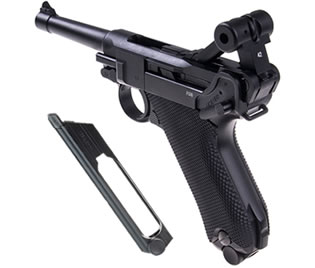
Exhibiting impressive authenticity, the Umarex Legends P.08 blowback air pistol uses a detachable 21 round box magazine that contains both the 12-gram CO2 capsule and a charge of 21 steel BBs, allowing for additional magazines to be carried for a quick and authentic reload. All-metal construction provides the weight (32 ounces) and heft of a real P.08 semi-auto. With a double action trigger you can shoot as fast as you can pull the trigger.
The Legends P0.8 blowback air pistol offers a fully-operational toggle action, exactly like that of the Luger firearm. While the actual action cycle of the toggle may be very slightly slower than that of the Luger firearm, it really gives a kick to the gun when its fired. The toggle also locks up when the magazine is empty. Again, just like the firearm. This is a very realistic action.
The trigger of the Legends P08 blowback pistol has that unusual, almost fully curved, design of the Luger firearm also. Not only that, but the external part of the trigger mechanism flexes when the trigger is pulled. Again, just like the firearm. Trigger pull is short and crisp. Similar to the original, its actually better than some of the Luger firearms.
|
Airgun Specifications:
|
Airgun Features:
|
More information about this product.
Additional Umarex Legends P.08 (Blowback) Photos
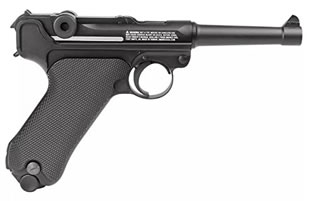
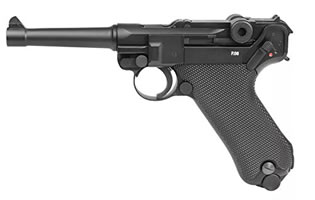
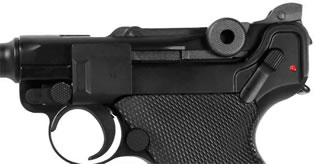
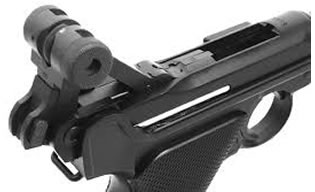
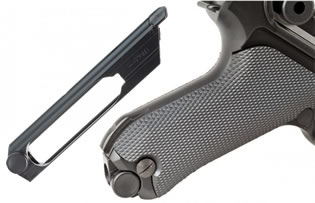
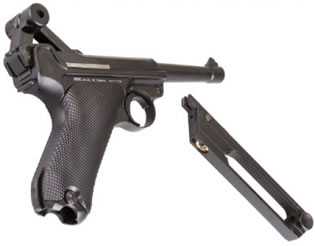

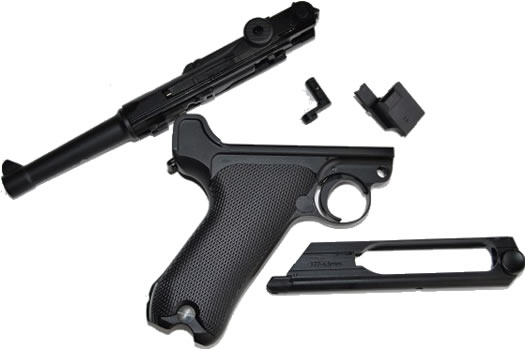
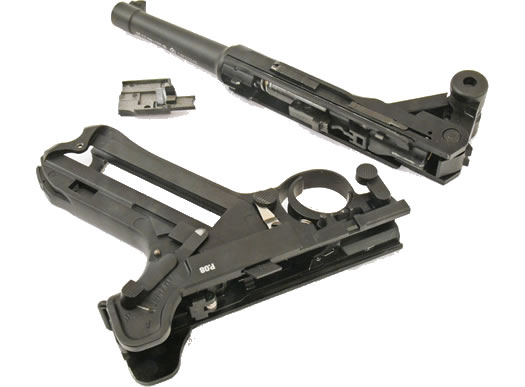
Amazon.com Product and Customer Reviews
Most helpful customer reviews
0 of 0 people found the following review helpful.
![]() Awesome gun! I hav never expected a airsoft this ...
Awesome gun! I hav never expected a airsoft this ...
By By Amazon Customer
Awesome gun! I hav never expected such high quality. If you are a collector or a target practice type of person, this will be a great buy
0 of 1 people found the following review helpful.
![]() Three Stars
Three Stars
By Amazon Customer
good gun but the trigger doest rest idk why came that way. easy fix though
5 of 6 people found the following review helpful.
![]() Interesting air gun...
Interesting air gun...
By Samuel
Good revolver, looks almost identical to my real steel Nagant revolver. It field strips in the same manner as the real deal which makes it cool in that regard. The trigger pull is very nice and not nearly as bad as the real one, so double action shooting with this gun is fairly effective. The revolver feels very nice in the hand and points very naturally just like the original. The gun shoots very close to point of aim at around 50 feet which is good since there is no adjustable hop up nor adjustable sights. This gun is very gas conservative and I got 40-50 shots off before I noticed the gas pressure starting to go down.
Some of the parts such as the ejector rod are rather loose on the gun and feels somewhat flimsy. The ejector rod itself is held in by a little spring somewhere in the frame and feels awkward the first few times you unscrew the ejector rod. The hammer is a little loose as well and I'm currently looking for a way to tighten it, so I would not recommend dry firing this gun a million times as you are likely to eventually cause damage to the hammer. The other thing I'm not particularly thrilled about is the fact it is nearly impossible to find the spare shells for this gun. If you use this gun in a skirmish which nobody but me would really do I would keep the shells in the gun and load from the front of the cylinder since loosing the shells is probably the fastest way to put this revolver out of action.
Overall I think that this revolver is very unique and does the original firearm justice in the way of being a good air gun replica. This gun would serve anybody well so long as they are aware of the limitations that this gun has in terms of quality and availability of parts.
History behind the firearm that inspired the Umarex Legends P.08 Air Pistol
Originally developed in 1898 and put into production in 1900, the cartridge-firing P.08 is another of the earliest semi-auto designs that saw use in both WWI and WWII. It is also one of the most recognized handguns in the world. These superb reproductions by Georg Luger proud.
The Pistole Parabellum 1908 Parabellum-Pistole (Pistol Parabellum) a toggle-locked recoil-operated semi-automatic pistol. The design was patented by Georg J. Luger in 1898 and produced by German arms manufacturer Deutsche Waffen- und Munitionsfabriken (DWM) starting in 1900 with other manufacturers such as W+F Bern, Krieghoff, Simson, Mauser, and Vickers; it was an evolution of the 1893 Hugo Borchardt designed C-93. The first Parabellum pistol was adopted by the Swiss army in May 1900. In German Army service, it was succeeded and partly replaced by the Walther P38 in caliber 9x19mm Parabellum.
The Luger is well known from its use by Germans during World War I and World War II, along with the interwar Weimar Republic and the postwar East German Volkspolizei. Although the P.08 was introduced in 7.65mm Parabellum, it is notable for being the pistol for which the 9x19mm Parabellum (also known as the 9x19mm Luger) cartridge was developed. Because of its association with Nazi Germany, the pistol has been used in fictional works by many villainous characters over the past several decades.
P.08 Design
One of the first semi-automatic pistols, the Luger was designed to use a toggle-lock action, which uses a jointed arm to lock, as opposed to the slide actions of almost every other semi-automatic pistol. After a round is fired, the barrel and toggle assembly (both locked together at this point) travel rearward due to recoil. After moving roughly 13 mm (0.5 in) rearward, the toggle strikes a cam built into the frame, causing the knee joint to hinge and the toggle and breech assembly to unlock. At this point the barrel impacts the frame and stops its rearward movement, but the toggle assembly continues moving (bending the knee joint) due to momentum, extracting the spent casing from the chamber and ejecting it. The toggle and breech assembly subsequently travel forward under spring tension and the next round from the magazine is loaded into the chamber. The entire sequence occurs in a fraction of a second. This mechanism works well for higher-pressure cartridges, but cartridges loaded to a lower pressure can cause the pistol to malfunction because they do not generate enough recoil to work the action fully. This results in either the breech block not clearing the top cartridge of the magazine, or becoming jammed open on the cartridge's base.
In World War I, as submachine guns were found to be effective in trench warfare, experiments with converting various types of pistols to machine pistols (Reihenfeuerpistolen, literally "row-fire pistols" or "consecutive fire pistols") were conducted. Among those the Luger pistol (German Army designation Pistole 08) was examined; however, unlike the Mauser C96, which was later manufactured in a selective-fire version (Schnellfeuer) or Reihenfeuerpistolen, the Luger proved to have an excessive rate of fire in full-automatic mode.
The Luger pistol was manufactured to exacting standards and had a long service life. William B. "Bill" Ruger praised the Luger's 14 (55‚ for Americans) grip angle and duplicated it in his .22 LR pistol.
Collecting the P.08
Although outdated, the Luger is still sought after by collectors both for its sleek design and accuracy, and for its connection to Imperial and Nazi Germany. Limited production of the P.08 by its original manufacturer resumed when Mauser refurbished a quantity of them in 1999 for the pistol's centennial. More recently, Krieghoff announced the continuation of its Parabellum Model 08 line with 200 examples at $17,545.00 apiece.
In 1923, Stoeger, Inc. obtained the American trademark for the "Luger" name for the import of German-built parabellum pistols into the United States. The 1923 commercial models, in .30 Luger and 9mm, and with barrel lengths from 75 mm to 600 mm were the first pistols to bear the name "Luger", roll stamped on the right side of the receiver. Stoeger has retained the rights to the "Luger" name. Over the past seven decades, Stoeger imported a number of different handguns under the "Luger" mark, including an Erma-built .380 version and an American-manufacture .22 which only remotely resembled the original design.
In 1991, the Houston, Texas firm of Aimco, Inc. began making an all new remake of the original Georg Luger design. At that time Mitchell Arms, Inc., under the "Mitchell" name marketed Aimco "new" parabellum. Stoeger, Inc. bought the rights to market the Texas-built pistols in 1994, and since that time the "Luger" name is once again on these toggle-action autoloaders.
Stoeger current offering is named the "American Eagle" model. This refers to the U.S. eagle roll-stamped above the chamber, closely resembling the eagle used to mark the original pistols designated for U.S. import. The "American Eagle" is available in 4-inch and 6-inch barrel lengths in 9x19mm Luger only.
Thousands were taken home by returning Allied soldiers during both wars, and are still in circulation today. Colonel David Hackworth mentions in his autobiography that it was still a sought-after sidearm in the Vietnam War. In 1945 Mauser set up again the Luger production under the control of the French forces. In 1969, Mauser Werke in Oberndorf restarted the production until 1986 when the last commemorative model was produced.
